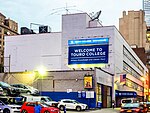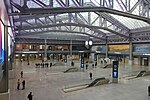James A. Farley Building

The James A. Farley Building is a mixed-use structure in Midtown Manhattan, New York City, which formerly served as the city's main United States Postal Service (USPS) branch. Designed by McKim, Mead & White in the Beaux-Arts style, the structure was built between 1911 and 1914, with an annex constructed between 1932 and 1935. The Farley Building, at 421 Eighth Avenue between 31st Street and 33rd Street in Midtown Manhattan, faces Pennsylvania Station and Madison Square Garden to the east. The main façade of the Farley Building (over 8th Avenue) features a Corinthian colonnade—the largest of its style in the world—finishing at a pavilion on each end. The imposing design was meant to match that of the original Pennsylvania Station across the street. An entablature above the colonnade bears the United States Postal Service creed: "Neither snow nor rain nor heat nor gloom of night stays these couriers from the swift completion of their appointed rounds." The colonnade’s inner ceiling is decorated with the crests or emblems of ten major nations that existed at the building's completion. The remaining three façades have a similar but simpler design. The James A. Farley Building was known as the Pennsylvania Terminal until 1918, when it was renamed the General Post Office Building. The building was made a New York City designated landmark in 1966 and was added to the National Register of Historic Places in 1973. It was officially renamed in 1982 in honor of James Farley who was the nation's 53rd Postmaster General and served from 1933 to 1940. The building was sold to the New York government in 2006. The interior space that once housed the main mail sorting room now houses the Moynihan Train Hall since 2021. Office space in the building was leased to Facebook in 2020.
Excerpt from the Wikipedia article James A. Farley Building (License: CC BY-SA 3.0, Authors, Images).James A. Farley Building
8th Avenue, New York Manhattan
Geographical coordinates (GPS) Address External links Nearby Places Show on map
Geographical coordinates (GPS)
| Latitude | Longitude |
|---|---|
| N 40.751111111111 ° | E -73.995277777778 ° |
Address
James A. Farley Building
8th Avenue 421
10199 New York, Manhattan
New York, United States
Open on Google Maps







